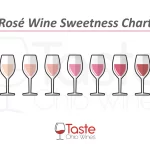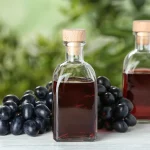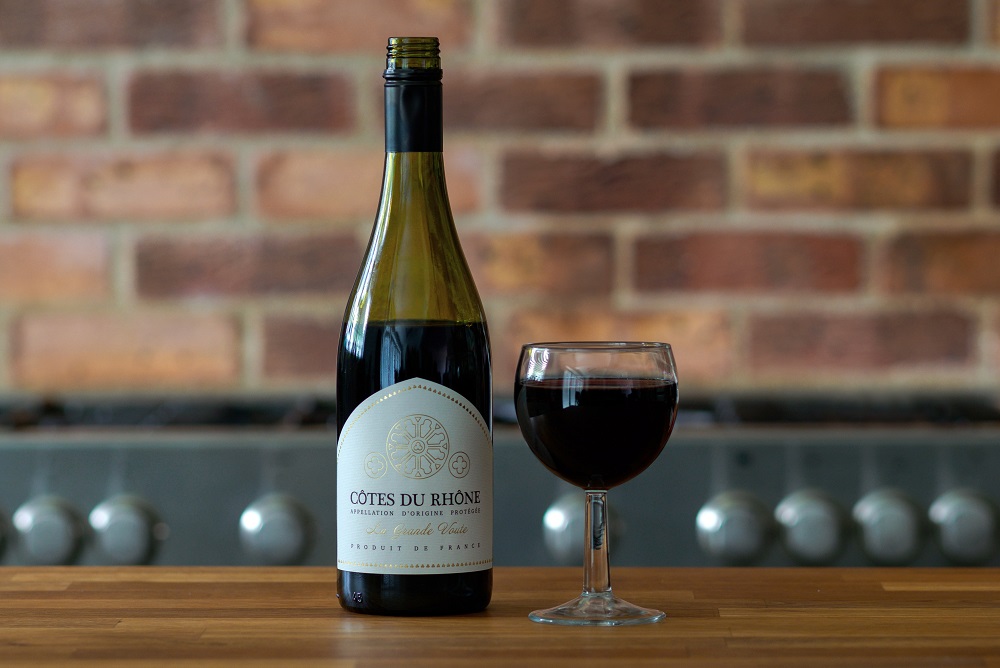Did you know that sweet wine drying techniques date back to the eighth century and were created primarily as a way to increase the lifespan of a bottle of wine?
It’s true! However, these wines have become some of the most popular options around the world, particularly in the luscious sweet red variety.
Here’s what you need to know about sweet red wines before you buy a bottle.
You may also be interested in our white wine dryness chart or rose wine dryness chart.
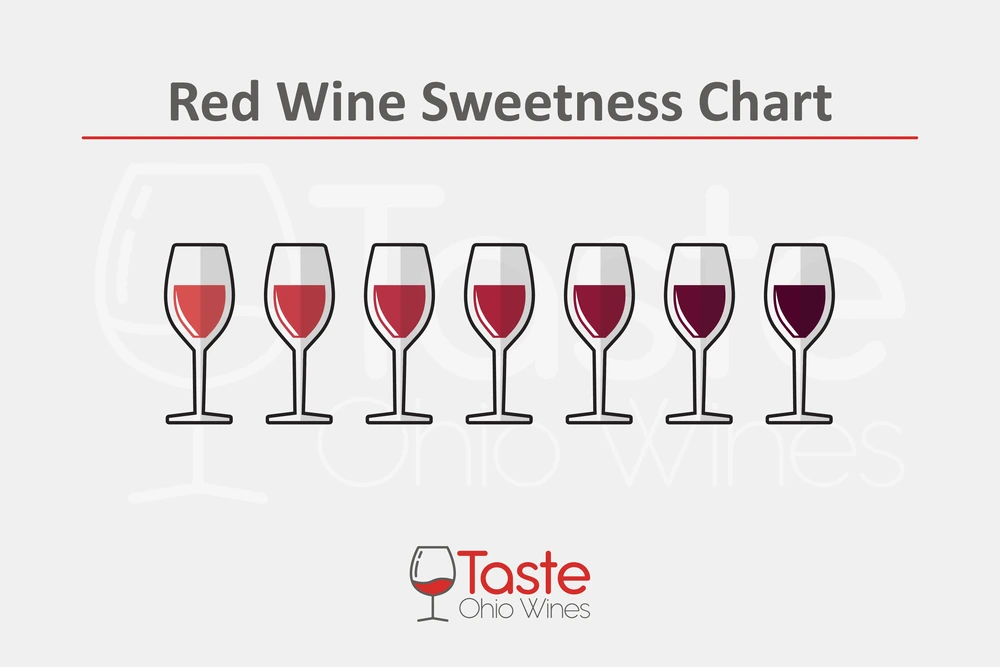
Find Out Which Wines Are Sweet Using This Useful Chart
If you’re interested in sweet wines, there is a wide variety of options available for your needs.
We examined some of the most common of these sweet wines to create this chart.
Here’s what you need to know about sweet wines in general:
Port Wine – This variety typically comes from Portugal and includes red, white, rose, and tawny wines.
The latter type is usually the sweetest port wine and has a sweetness level of 150 grams of sugar per bottle. Expect a caramel taste and a bitter chocolate undertone with this wine.
White Zinfandel – A sweet white zinfandel has a maximum sugar rating of about 120 grams but may be as low as 35 grams.
The differences mostly lay within individual wine companies. Expect a relatively light body and a sweet taste of peaches and cherries with this delicious variety.
Sauternes – Using a sweetening technique known as noble rot (utilizing a fungus to concentrate each grape’s sugar), this one has medium acidity with a nutty aftertaste.
Expect a lingering sense of butterscotch and peach as well, with a sweetness rating of 120-220 grams.
These sweet wines are some of the most popular globally and will go well for many tastes. However, there are other options available that may work for you, depending on your preference as a wine drinker.
Sweetness Chart for Red Wine
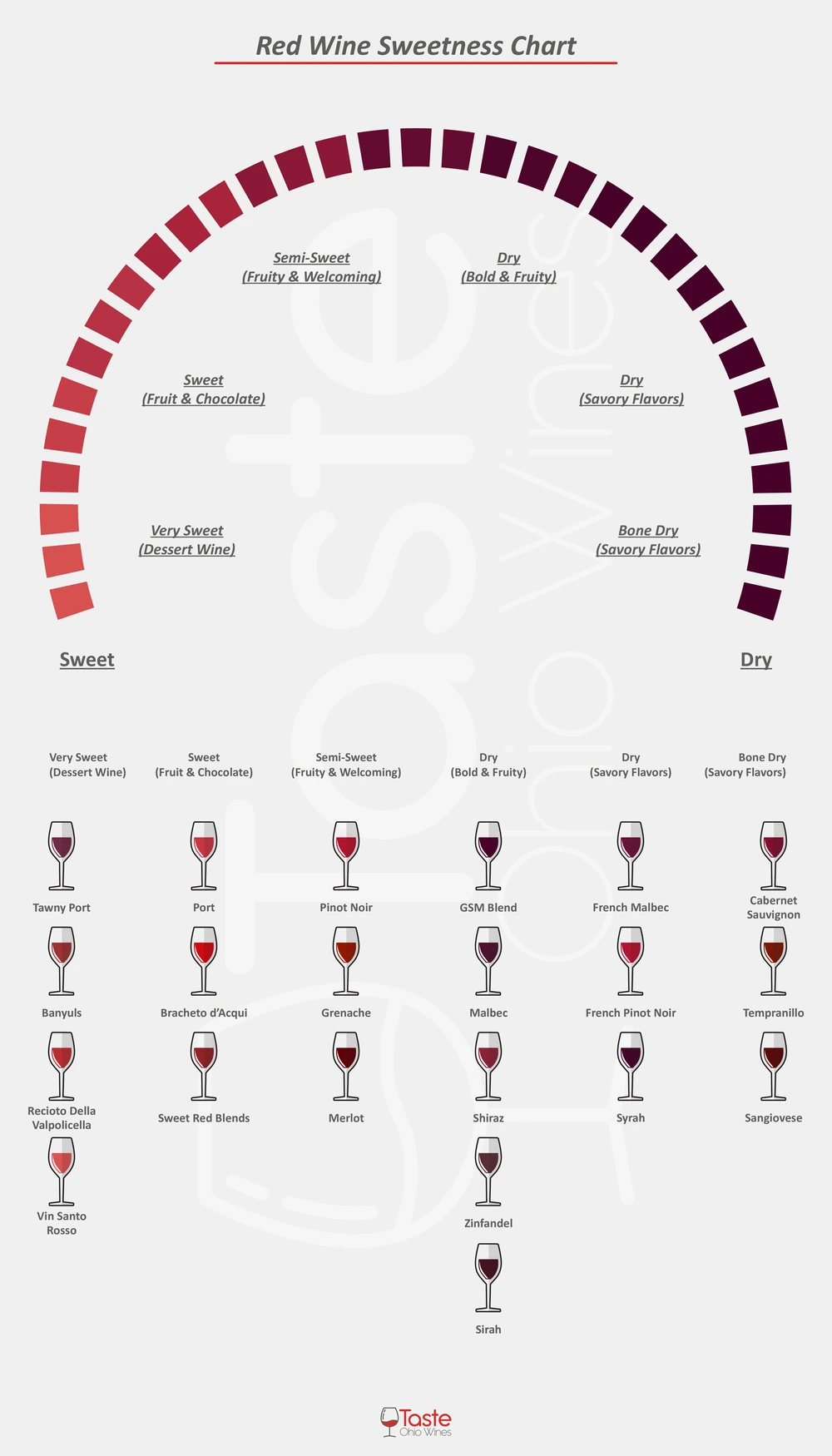
Share this Image On Your Site
In this section, you’ll learn more about how sweet red wines are classified.
They break down into three dry categories, two sweet types, and a middle option that works well for those with a more balanced wine taste. When looking for sweet red wines, use this chart to get started:
- Bone Dry (Savory Flavors) – Cabernet Sauvignon, Tempranillo, Sangiovese
- Dry (Savory Flavors) – French Malbec, French Pinot Noir, Syrah
- Dry (Bold & Fruity) – GSM Blend, Malbec, Shiraz, Zinfandel, Sirah
- Semi-Sweet (Fruity & Welcoming) – Pinot Noir, Grenache, Merlot
- Sweet (Fruit & Chocolate) – Lambrusco, Rosso Dolce, Brachetto D’Acqui, Beaujolais Nouveau, Port, Sweet Red Blends
- Very Sweet (Dessert Wine) – Tawny Port, Ruby Port, Vin Santo Rosso, Recioto Della Valpolicella
Before buying a bottle of these sweet red wines, you need to read the guide below to figure out how much sugar each sweetness level possesses.
Wine Sweetness
Wine sweetness is rated based on the number of grams of sugar in each bottle.
People who don’t like the sweet taste or who may have diabetes or other health conditions may find themselves steering clear of sweeter wines. In this guide, you’ll get a more in-depth look at how much sugar is typically in each sweetness level:
- Bone Dry – Less Than 1 Gram: Bitter Mineral Taste
- Dry – Less Than 10 Grams: High Acidity
- Semi-Sweet – 10-35 Grams: Contains Sweet Fruit Flavors
- Sweet – 35-120 Grams: Taste Varies Based on Wine Type
- Very Sweet (Dessert) – 120-220 Grams: Great for After-Dinner Drinking
Pay attention to the rating on your bottle or in its description to ensure you choose a sweetness that you enjoy.
Then, you can read the list below to learn about specific sweet red wine options for your needs. These wines should be available from just about any wine vendor.
Sweet Red Wines
Now that you understand a bit about how sweet red wines are rated let’s go over a few of the most popular options available on the market.
These unique wines are quite delicious and will go well with just about any meal or drinking situation. They include:
Pinot Noir – When most people think of sweet red wines, they likely think of Pinot Noir.
It works beautifully for people who want a light to medium-body wine, this sweet red will blend well with just about any meal or drinking situation. Many love it as a simple nightcap.
Just make sure you actually pick a sweet Pinot Noir, as most tend to be dry and only have the appearance of being sweet. This is mostly due to their aroma.
Sangiovese – This wine is made from one of the most famous Italian grapes in the world.
Wine fans enjoy this savory blend, which includes a reasonably herbal taste mixed with cherry, plums, violets, and more. If you’ve ever eaten a big Italian dinner, you’ve probably topped it off with Sangiovese.
Cabernet Franc – As a light-bodied variation on the Cabernet Sauvignon, this wine possesses a variety of different taste notes.
Expect a hint of blackberries and even a touch of sweeter tobacco aromas. Try this wine with a decadent dinner, as it helps with digesting some pretty intense meals.
Carmenere – Produces a very nice flavor mix that includes blackberry, cedar, cocoa, and blackcurrant textures.
One sniff of this wine will tell you what you need to know: that nearly green bell pepper scent indicates that this wine is potent and a good option for many palates.
Lambrusco – Do you like sparkling or semi-sparkling reds? You’ll enjoy this sweet variety.
It probably works best as a semi-sweet paired with cured meats. Pork fans often find themselves drawn to this variety, as it gives a nice punch to the meal without overwhelming the meat taste.
Zinfandel – Red zinfandel wines can vary from relatively dry to surprisingly sweet.
The rose zinfandel is exceptionally delicious and works well as a dessert wine paired with various types of meats. However, it probably goes best with tomato-sauce pasta dishes, including pizza.
Syrah – Sweet red wines don’t get much bolder than this excellent blend.
Typically, varieties possess a gamey texture with a smoky aftertaste that will remind most people of licorice. You can also expect plum, black pepper, and blueberry aftertastes with this variety.
These varieties are just a few of the most common and well-loved sweet reds available today.
We didn’t even have room to talk about Tempranillo (a famous Spanish wine), Grenache (reasonably dry but with a potent ripeness), and Corvina (chocolate aftertaste) wine varieties.
Wines Recommended For Dessert
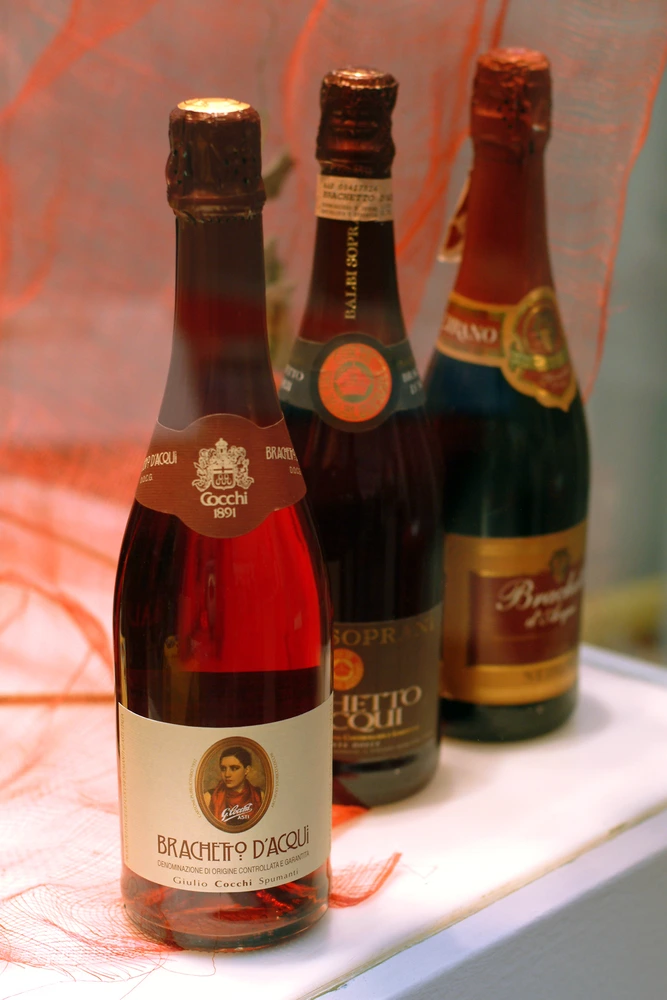
Sweet red wines often make the perfect dessert option, as they contain a rich blend of aftertastes and undertones that enhance your meal enjoyment.
Red wines also help with digestion by providing a myriad of essential gut enzymes. Just a few types you might like after dinner include:
Late-Harvest Reds – Any late-harvest red (particularly US wines made with Zinfandel and Petite Sirah grapes) should work well as a dessert wine.
They’ll possess a medium-sweet to delightful sugar content that makes them a good palate cleanser after a meal.
Brachetto d’Acqui – Works very well for various pairings, including with cured meats and rich potato-heavy meals.
As a bubbly red wine, it produces a floral and strawberry aroma that creates a reasonably rich and refreshing taste that should help your food digest a bit more smoothly.
Freisa – This option remains a prevalent red throughout many regions, particularly in Piedmont.
It produces a reasonably strong cherry taste with a touch of floral undertones. Expect lighter tannins with this wine, particularly the medium-sweet varieties.
Spätlese Riesling – This dessert wine includes the dry Kabinett up to the Eiswein, which is medium-sweet.
This wine goes well with just about any meal, particularly if you want a medium-sweet variety that doesn’t overwhelm you with sugar.
Vinsanto – This sun-dried dessert wine must be aged at least two years before serving.
Expect a wide variety of flavors and aromas that produces a reasonably dark hue.
When enjoying a dessert red wine, pour and serve at room temperature, waiting a few minutes after you’re done with your meal before you drink. Waiting lets your food settle a little and gives you time to chat with your partner or any friends you may have invited over for dinner that day!
- Shrimp Cocktail (and More) Wine Pairing Guide - 09/06/2022
- What Wine Serving Sizes Look Like: Standard Size and More - 08/06/2022
- How Much Sugar is in Wine: Glass and Bottle Sugar Content - 08/06/2022

